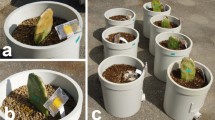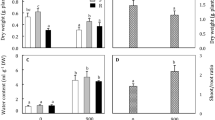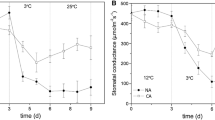Abstract
Although the cold-resistant ability of mangroves varies greatly with species, the physiological mechanism remains unclear. The chilling stress effects on morphological changes, photosynthetic pigments, reactive oxygen species (ROS), malondialdehyde (MDA) and several antioxidants, were studied in leaves of three mangrove seedlings (Kandelia obovata, Aegiceras corniculatum and Avicennia marina). Results showed that both K. obovata and A. corniculatum exhibited lighter chilling damage, lower chilling injury rates and higher survival rates compared to A. marina. Reductions of chlorophylls (Chls) were observed in all the three mangroves, and the highest was detected in A. marina. Significant increases in content of ROS (hydrogen peroxide, H2O2; hydroxyl radicals, OH⋅) and MDA were observed in both A. marina and A. corniculatum, whereas chilling stressed K. obovata showed a decrease in H2O2 content, constant OH⋅ level and instantaneous increase of MDA. The contents of proline and water-soluble protein exhibited similar stress-time dependent increases in all mangroves, while A. corniculatum showed the highest increase of proline and relatively higher increase of water-soluble protein. The catalase activities significantly decreased with stress time in all mangroves, while K. obovata showed the least reduction. An increase in ascorbic acid (AsA) content and activities of superoxide dismutase, peroxidase (POD), and ascorbate peroxidase (APX) were also detected in all the three mangroves, while K. obovata showed the highest increases. These results indicate that chilling-tolerance of mangroves is associated with the efficiency of antioxidants, as confirmed by principal component analysis. The AsA, APX and POD in K. obovata may play more important role in control of oxidative stresses than those in the other two species. Furthermore, the higher cold-resistance of A. corniculatum compared to A. marina may be partly associated with its higher proline accumulation. The results indicate that enzymatic and non-enzymatic antioxidants (POD, APX, AsA, proline and Car) play key roles in scavenging of excess ROS in mangroves. Further studies focusing on these stress-responsive genes will enable better understanding of the cold-resistance mechanism from molecular level.





Similar content being viewed by others
References
Alexieva V, Sergiev I, Mapelli S, Karanov E (2001) The effect of drought and ultraviolet radiation on growth and stress markers in pea and wheat. Plant Cell Environ 24:1337–1344
Alscher RG, Erturk N, Heath LS (2002) Role of superoxide dismutases (SODs) in controlling oxidative stress in plants. J Exp Bot 53:1331
Apel K, Hirt H (2004) Reactive oxygen species: metabolism, oxidative stress, and signal transduction. Annu Rev Plant Biol 55:373–399
Asada K (1997) The role of ascorbate peroxidase and monodehydroascorbate reductase in H2O2 scavenging in plants. Cold Spring Harb Monogr Arch 34:715–735
Aydin SS, Büyük İ, Aras S (2013) Relationships among lipid peroxidation, SOD enzyme activity, and SOD gene expression profile in Lycopersicum esculentum L. exposed to cold stress. Genet Mol Res 12(3):3220–3229
Babbs CF, Gale MJ (1987) Colorimetric assay for methanesulfinic acid in biological samples. Anal Biochem 163:67–73
Bates L, Waldren R, Teare I (1973) Rapid determination of free proline for water-stress studies. Plant Soil 39:205–207
Beauchamp C, Fridovich I (1971) Superoxide dismutase: improved assays and an assay applicable to acrylamide gels. Anal Biochem 44:276
Bonnes-Taourel D, Guérin MC, Torreilles J (1992) Is malonaldehyde a valuable indicator of lipid peroxidation? Biochem Pharmacol 44:985–988
Bradford MM (1976) A rapid and sensitive method for the quantitation of microgram quantities of protein utilising the principle of protein-dye binding. Anal Biochem 72:248–254
Chen LZ, Wang WQ, Zhang YH et al (2010) Damage to mangroves from extreme cold in early 2008 in southern China. Chin J Plant Eco 34:186–194
Dipierro S, De Leonardis S (1997) The ascorbate system and lipid peroxidation in stored potato (Solanum tuberosum L.) tubers. J Exp Bot 48:779–783
Feierabend J (2007) Catalases in plants: molecular and functional properties and role in stress defence. In: Smirnoff N (ed) Antioxidants and reactive oxygen species in plants. Blackwell Publishing, Oxford, pp 101–140
Fortunato AS, Lidon FC, Batista-Santos P, Eduardo Leitão A, Pais IP, Ribeiro AI, Cochicho Ramalho J (2010) Biochemical and molecular characterization of the antioxidative system of Coffea sp. under cold conditions in genotypes with contrasting tolerance. J Plant Physiol 167:333–342
Foyer CH, Noctor G (2005) Redox homeostasis and antioxidant signaling: a metabolic interface between stress perception and physiological responses. Plant Cell Online 17:1866–1875
Hogarth PJ (1999) The biology of mangroves. Oxford University Press, Oxford, p 228
Jaleel CA, Riadh K, Gopi R et al (2009) Antioxidant defense responses: physiological plasticity in higher plants under abiotic constraints. Acta Physiol Plant 31:427–436
Kampfenkel K, Vanmontagu M, Inze D (1995) Extraction and determination of ascorbate and dehydroascorbate from plant tissue. Anal Biochem 225:165–167
Kuk YI, Shin JS, Burgos NR, Hwang TE, Han O, Cho BH, Jung S, Guh JO (2003) Antioxidative enzymes offer protection from chilling damage in rice plants. Crop Sci 43(6):2109–2117
Kumar V, Yadav SK (2009) Proline nd betaine provide protection to antioxidant and methyglyxoal detoxification systems during cold stress and Camellia sinensis (L.) O. Kuntze. Acta Physiol Plant 31:261–269
Kumar S, Kaur G, Nayyar H (2008) Exogenous application of abscisic acid improves cold tolerance in chickpea (Cicer arietinum L.). J Agron Crop Sci 194(6):449–456
Kurbidaeva AS, Novokreshchenova MG (2011) Genetic control of plant resistance to cold. Russ J Genet 47:646–661
Lin P, Shen R, Lu C (1994) The characteristics of chilling-resistance on six mangrove plants. J Xiamen Univ 33:249–252
Logan BA (2005) Reactive oxygen species and photosynthesis. In: Smirnoff N (ed) Antioxidants and reactive oxygen in plants. Blackwell Publishing, Oxford, pp 250–267
Lou L, Shen Z, Li X (2004) The copper tolerance mechanisms of Elsholtzia haichowensis, a plant from copper-enriched soils. Environ Exp Bot 51:111–120
Miyake C, Asada K (1994) Ferredoxin-dependent photoreduction of the monodehydroascorbate radical in spinach thylakoids. Plant Cell Physiol 35:539–549
Nakano Y, Asada K (1981) Hydrogen peroxide is scavenged by ascorbate-specific peroxidase in spinach chloroplasts. Plant Cell Physiol 22:867–880
Niyogi KK, Bjorkman O, Grossman AR (1997) Chlamydomonas xanthophyll cycle mutants identified by video imaging of chlorophyll fluorescence quenching. Plant Cell Online 9:1369–1380
Quisthoudt K, Schmitz N, Randin CF et al (2012) Temperature variation among mangrove latitudinal range limits worldwide. Trees 26:1919–1931
Ryu K, Dordick JS (1992) How do organic solvents affect peroxidase structure and function? Biochem 31:2588–2598
Saruyama II, Tanida M (1995) Effect of chilling on activated oxygen-scavenging enzymes in low temperature-sensitive and tolerant cultivars of rice (Oryza sativa L.). Plant Sci 109:105–113
Scebba F, Sebastiani L, Vitagliano C (1999) Protective enzymes against activated oxygen species in Wheat (Triticum aestivum L.) seedlings: responses to cold acclimation. J Plant Physiol 155:762–768
Shevyakova N, Bakulina E, Kuznetsov VV (2009) Proline antioxidant role in the common ice plant subjected to salinity and paraquat treatment inducing oxidative stress. Russ J Plant Physiol 56:663–669
Shigeoka S, Ishikawa T, Tamoi M, Miyagawa Y, Takeda T, Yabuta Y, Yoshimura K (2002) Regulation and function of ascorbate peroxidase isoenzymes. J Exp Bot 53:1305–1319
Verbruggen N, Hermans C (2008) Proline accumulation in plants: a review. Amino Acids 35:753–759
Winfield MO, Lu C, Wilson ID et al (2010) Plant responses to cold: transcriptome analysis of wheat. Plant Biotechnol J 8:749–771
Wise RR (1995) Chilling-enhanced photooxidation: the production, action and study of reactive oxygen species produced during chilling in the light. Photosynth Res 45:79–97
Acknowledgments
This research was supported by the National Natural Science Foundation of China (No. 41430966 and No. 41176101), the key projects in the National Science & Technology Pillar Program in the Eleventh Five-year Plan Period (No. 2012BAC07B0402), the Projects of Guangzhou Science and Technology (No. 15020024) and the projects of the Knowledge Innovation Program of the Chinese Academy of Sciences (No. KSCX2-SW-132).
Conflict of interest
The authors declare that they have no conflict of interest.
Author information
Authors and Affiliations
Corresponding author
Rights and permissions
About this article
Cite this article
Peng, YL., Wang, YS., Fei, J. et al. Ecophysiological differences between three mangrove seedlings (Kandelia obovata, Aegiceras corniculatum, and Avicennia marina) exposed to chilling stress. Ecotoxicology 24, 1722–1732 (2015). https://doi.org/10.1007/s10646-015-1488-7
Accepted:
Published:
Issue Date:
DOI: https://doi.org/10.1007/s10646-015-1488-7




